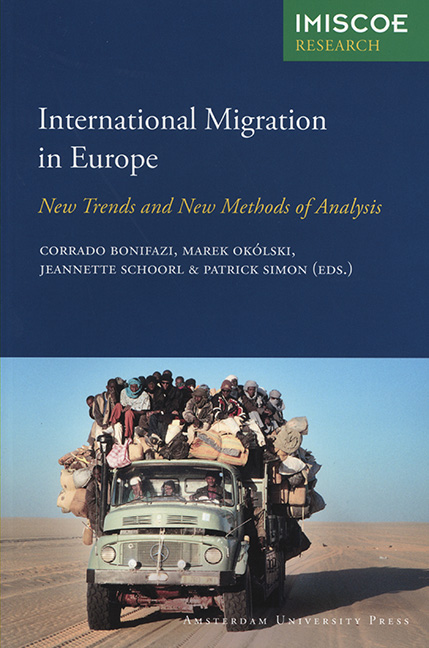Book contents
- Frontmatter
- Contents
- Preface
- 1 Introduction
- PART I NEW FORMS OF MIGRATION IN EUROPE
- PART II EVOLUTION OF REGIONAL PATTERNS OF INTERNATIONAL MIGRATION IN EUROPE
- PART III MEASURING INTEGRATION: IMMIGRANTS AND THE SECOND GENERATION
- PART IV SPECIAL SURVEYS IN INTERNATIONAL MIGRATION STUDIES
- List of Contributors
- Index
- Other IMISCOE Titles
6 - Evolution of Regional Patterns of International Migration in Europe
Published online by Cambridge University Press: 22 June 2021
- Frontmatter
- Contents
- Preface
- 1 Introduction
- PART I NEW FORMS OF MIGRATION IN EUROPE
- PART II EVOLUTION OF REGIONAL PATTERNS OF INTERNATIONAL MIGRATION IN EUROPE
- PART III MEASURING INTEGRATION: IMMIGRANTS AND THE SECOND GENERATION
- PART IV SPECIAL SURVEYS IN INTERNATIONAL MIGRATION STUDIES
- List of Contributors
- Index
- Other IMISCOE Titles
Summary
Introduction
International migration trends are the result of many elements. Demographic contexts, economic and social conditions, political choices, international links, historical ties, and cultural factors play, at different levels, an important role in determining the size and directions of migration flows. Globalisation processes and the end of the Iron Curtain have been powerful factors in promoting human mobility and in accelerating the evolution of migration. The result is the increasingly complex and changeable picture that has characterised world migration in the last twenty years. During this period, some countries and regions have suddenly changed their role in migration systems. New destinations have unexpectedly emerged, whilst unforeseen connections have appeared.
The recent evolution of European international migration has been marked by the general and gradual enlargement of the migration system centred on the EU countries. This process was clearly encouraged, if not largely determined, by the enlargement of the EU. Six members originally signed the Treaty of Rome in 1957 but between 1973 and 1995 another nine countries joined so that almost all of Western Europe was covered. With the ten new members of May 2004 and the further two in January 2007, we now have an area of free circulation that covers a large part of the continent, thus enlarging further the size of a supranational entity that increasingly assigns an important role to migration policies.
There have also been important changes in the migration scenario in these years, for example, the former emigration countries of Southern Europe have increasingly become targets for immigration flows, radically changing their position in migration dynamics. Another development has been the way in which some of the new members of the EU are already becoming destination countries. Notwithstanding these processes, differences persist and contribute to the heterogeneity of trends, patterns and prospects within Europe.
This chapter analyses the evolution of the regional patterns that have characterised European international migrations since World War II. This is a way of interpreting migration trends that can be very useful, above all given the fact that the different steps in the evolution of international migration experienced by a region or a country are a useful point of reference from which to analyse the trends and patterns of another area and to infer possible future scenarios (Salt 1989).
- Type
- Chapter
- Information
- International Migration in EuropeNew Trends and New Methods of Analysis, pp. 107 - 128Publisher: Amsterdam University PressPrint publication year: 2008
- 3
- Cited by



